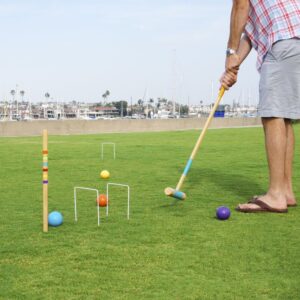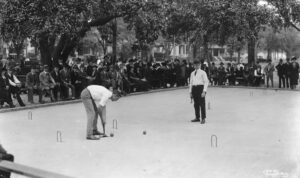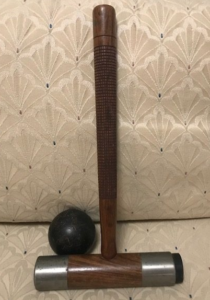An Unknown Roque Champion
When I was entering into my teenage years, a game we called “croquet” was really becoming popular in downstate Illinois.
My niece, Nancy Casey, writes eloquently of her memories of it:
Weldon is a small town in central Illinois — farm country. When I was four or five, my dad, Uncle Ike, and Grandpa would take me at night to the croquet court at the end of Main Street, just across from the hotel that my Great Grandma Gray ran.
It was all lit up with overhead lights and all the men had their own wooden croquet mallets. My mom Wanda, now 94, still has two of them. The men played while I watched. The court seemed pretty big to me.
Because of this introduction to the game, we always had a croquet set when my son Scott was growing up and we played in the back yard. I now have a very fancy croquet set that Scott got me for Christmas one year.
One time when we visited Scott’s Simon Island house, we drove over to Jeckyl Island where there is a big fancy hotel with a huge grass croquet court in front of it. All the people were out in all white clothes playing croquet.
It may be a sophisticated game, but I remember Weldon and all the men playing croquet on a summer’s eve in the middle of the midwest farm country.
As Nancy observes, people played “lawn croquet,” where you set up thin wire arches in your sometimes bumpy yard, and use a long handled mallet to hit wooden balls through them.
Invented in France and brought to the U.S. from England, it was a game that provided entertainment for a lot of people.
But as Nancy also hinted, the game the men she watched were playing, lights and all, was different– and therein lies this tale.
So What Made Our Game Different?
The “croquet court” the men built and played on in my hometown, Weldon, Illinois, looked a lot like the court below, if you throw in some lights.
The Weldon court was surrounded by a six-inch high concrete wall, had a hard clay surface that was lightly covered by sand. The arches were made of steel, one inches thick. The game used a hard rubber ball, about three and a quarter inches in diameter, which barely went through the arch.
The mallet the men of Weldon used had a 15-inch handle. The head of the mallet, with soft rubber on one end and hard rubber on the other, was nine inches long. My dad’s mallet and ball are shown in the photo above.
Contrary to the “minor league” game of lawn croquet, this court croquet was a “major league” game of true shots and creative skill. We didn’t know the history or true name of our game, but we sure loved to play it.
My Grandfather, Emmett Gray, even built a court similar to the one shown above in the back yard of his home in Weldon.
A Revelation Late in Life
I was avidly playing our court croquet game when I was 12 years old, but it wasn’t until 75 years later — spurred on by some questions after a talk I gave — that I really found out what was going on.
To my surprise, I found the following definition in Dictionary.com:
Roque (noun) a form of croquet played on a clay or hard-surface court surrounded by a low wall off which the balls may be played.
And the following from Wikipedia, and the Encyclopedia of Sports:
Roque is an American variant of croquet played on a hard, smooth surface. Popular in the first quarter of the 20th century and billed “the Game of the Century” by its enthusiasts, it was an Olympic sport in the 1904 Summer Games, replacing croquet from the previous games.
Roque is played on a hard sand or clay 30 ft by 60 ft court bordered by a boundary wall, a curb bevelled at the ends to form an octagon. Players use a short handled mallet (15″-24″ long) to bank balls off the boundary wall similarly to how billiard balls are played off the cushions of a billiard table.
Lo and behold! I was playing roque and didn’t even know it!
A Little More Roque History
The roque players really thought they were on to something. A better game than croquet, invented right here in America! The Game of the Century.
According to Wikipedia,
The name “roque” was suggested by Samuel Crosby of New York City in 1899 who came to it by removing the initial “c” and final “t” from “croquet.”
C\ROQUE\T
The National Croquet Association, formed in 1882, thereafter changed its name to the National Roque Association in 1899.
To bring it close to home, the following is from Wikipedia, no less.
Roque is still played by a small number of people in the United States. An historic roque court in Clinton, Illinois was restored to playing condition in 2013. A roque tournament is held annually in Angelica, New York.
One Guy’s Experience With Roque
At my dad Ray Odaffer’s funeral in March 1950, as the shock of the farm accident that took his life was waning, people talked about how much he loved to play croquet.
Before that, my dad had talked about he and I playing in a croquet tournament sometime.
Sadly, my dad’s bucket list wouldn’t be completed. When I started to play again, I wondered if I should use his mallet, instead of my cheaper, youth mallet. Somehow, it didn’t seem right.
But over a year after he died, in August 1951 I decided to honor my dad by using his mallet in what I now know was the Little State Roque tournament in Clinton, Illinois.
I couldn’t do anything wrong. It seemed that every shot was perfect. I won the tournament going away! It felt like my dad was hitting the shots, not me. And maybe he was.
And I have a ribbon to prove it.
 Some Final Comments
Some Final Comments
Now, 70 years after that tournament, I am still honestly puzzled that roque did not make it as “The Game of the Century.”
It had everything: skill, creativity, cleverness, strategy, and steadiness. It was like standing on a giant billiard table. You could get better through practice and it was a lot of fun to watch. Wonderful competition!
Some people say it died out because television was coming in a big way, and roque players watched TV instead of using their time to play this enticing, exciting game.
So hard to understand. I still hold out hope that the game will be re-discovered and everybody will learn to love it.
But then I may be just wanting myself to be re-discovered as the Little State Illinois roque champion of 1951. Why not?





Bill Hammitt
I too loved to play croquet as a kid. The big front yard at The Bay Fold was perfect for the set up. I was never successful getting my kids interested in the game.
Janice Neuleib
Fascinating! I grew up playing in our front yard. My older siblings fought over the game, but I never built up the passion for it. You brought back memories!
Phares O'Daffer
Thanks for your reply, Jan. Thanks for your questions motivating me to look into the Roque part of this in a little more detail!
stacy chuchro odaffer
I love this so much!!!!! Glad too that we got to talk about it live and in person just last week. Not surprised at your championship ribbon either!